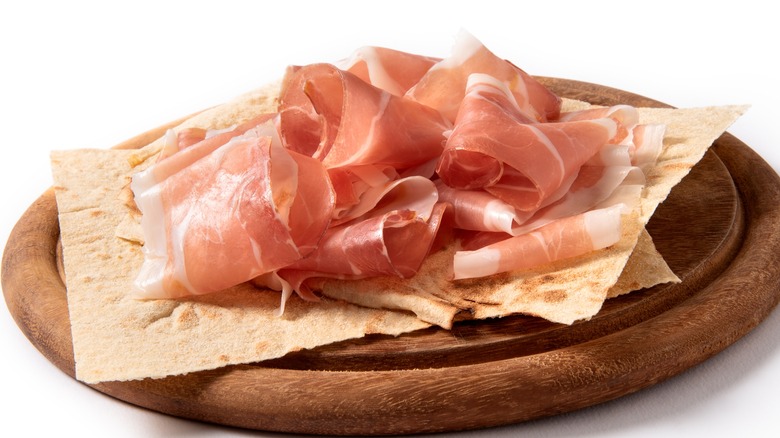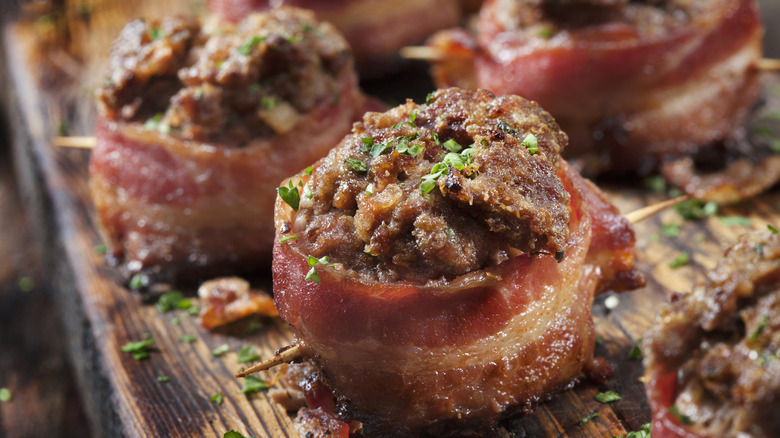The Real Difference Between Bacon And Speck
Pork comes in many forms, but few offer quickly satisfying results quite like cured products. Curing both extends shelf life and stops bacterial growth. From prosciutto to salami, there are a range of successful cured meats.
In the U.S., no cured meat is more famous than bacon. Enjoyable on its own and easy to cook with, it's a product with the perfect balance of fat and meatiness. It's no surprise that there's a medley of similar cured meats produced worldwide, each with its own intricacy. One such distinct cured pork product is speck. Produced in Germany and Italy, it's a spiced and complex meat with a tradition-rich production process. Speck is also cured and smoked but, unlike bacon, it can often be enjoyed right out of the package, lending it a charcuterie-like quality. It may not be a direct substitute for bacon, but it's worth picking up to showcase the beautiful range of cured pork.
What is bacon?
Bacon refers to a fatty cured pork cut typically seasoned with varying spices, brown sugar, and salt. The meat can be sourced from both the belly and back of the animal, oftentimes with streaks of meat and fat. The term encompasses several varieties, like the thicker Canadian bacon, but is most often associated with the American style.
This version of bacon is butchered into a slab, then cured and smoked. Typically raw, it has an especially high fat content with streaks of meat dispersed throughout. In addition to the common sliced strips, it can also be butchered to a center cut or kept as a large slab. Plus, modern-day bacon products can also be made from poultry, beef, and various vegan substitutes.
Regardless of the precise form, bacon is known for its crispy texture and its use as a fatty addition to dishes like stews. From sweet and salty bacon scones to a broccoli bacon Brussels salad, bacon is a malleable component in many applications; no wonder it's so beloved in American gastronomy.
What is speck?
Speck refers to several European cured pork products. Most associate it with a bold pork cut hailing from the South Tyrol region of Italy. However, several bacon-like German pork creations also hold the same name. Especially in the latter style, the term encompasses a range of fatty pork products, which can be either raw or processed.
Italian speck has a more definite composition and flavor, as many producers adhere to a federally regulated process. The traditional Italian speck stems from the leg of the pig, which is rubbed down with a fragrant spice mix containing bay leaves and juniper. After marinating for weeks, the pork is smoked at a low temperature, then finished with a cure, sealing in water and creating a thick exterior crust. Such laborious processing steps create a pork product with a bold taste, equal parts spiced, smokey, and savory. It's a more flavor-heavy product than its famed cousin prosciutto, instead more closely resembling pricey pancetta.
Speck can be enjoyed without preparation
Unlike bacon, speck is often ready to eat out of the package. Sliced thin at a deli or at home, it's a perfect addition to a charcuterie board. The rich flavor and intricate combination of spices meld with fruit, cheese, and other cold cuts to make it a great candidate for an all-Italian board. The cured pork is also a popular choice for sandwiches when paired with aromatic ingredients like arugula and varying cheeses. Speck also frequently functions as a garnish thinly chopped atop a savory meal.
As a cornerstone of the BLT, bacon is also a sandwich staple. However, regardless of the application, it's necessary to cook the meat for safe consumption. It can be prepared using a variety of straightforward methods and, unlike speck, is more often served warm. Plus, bacon can be employed for its cooking fat, a technique not utilized with speck.
Bacon and speck take on varying culinary uses
Speck's bold flavor and ready-to-eat format makes it especially useful as a garnish, but it's also cooked into dishes too. It's notably caramelized and stuffed in canederli, a beloved Italian bread dumpling. Cooked on a stove, it also makes for a delicious aromatic addition to stews. Or, speck can even be threaded onto a skewer and grilled. Plus, there are numerous raw applications, whether a porky garnish for rye spaetzle or the foundation of a charcuterie board.
Just like speck, bacon also lends to a diverse array of culinary uses. The wondrously malleable protein can wrap around everything from balsamic Brussels sprouts to cheese and crackers or serve as the chopped garnish atop a salad. It pairs well with a wide range of ingredients, like butternut squash in a quiche or creamy celery in a soup. Or, it can be a dominant flavor of its own in applications like bacon jam. Whether you prefer the aromatics of speck or bacon, both are cuts that are easy to use in the kitchen.




